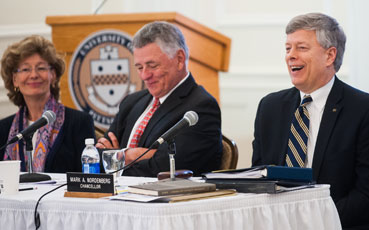Welcome Back: New chancellor must lead by diplomacy, not decree

August 19, 2013
Eighteen years ago, much of the incoming freshman class had not yet been born, Pitt Stadium still dominated the landscape of “Cardiac Hill” and the University’s endowment couldn’t claim half a billion dollars.
The University, which now welcomes those incoming freshmen, has noticeably matured right alongside them. And no conversation of this brochure-worthy development at Pitt over the past two decades ever strays far from one name: Mark Nordenberg.
Every common metric for quantifying University progress speaks to the success of Nordenberg’s career: a sextupling endowment, a 20-percent increase in the number of applications received and a place among the five most federally funded universities. All of these achievements – not to mention the residence hall named after him – testify on behalf of his stunning career, which is set to end in August 2014.
But the rapid ascent of this institution and its chancellor underscores a maxim that the Board of Trustees ought to consider when selecting his replacement: A senior administrator alone can steer a college either to success or failure.
This lesson has taken on a distinct urgency in the past few years. University presidents and chancellors across the nation are joining Nordenberg in his entrance to partial retirement, as the average age of senior administrators climbed to 61 in 2011.
The imminent withdrawal of a seasoned generation of administrators leaves fresh faces to inherit a position that has transformed beyond recognition over the past three decades. The new captains of higher education must often navigate miserly state governments, gargantuan marketing campaigns and transformative educational technology – all from one office.
The evolving responsibilities of a new generation of administrators have raised an important question for anyone associated with the University: What kind of leader should a chancellor be?
In the traditional liberal arts colleges of the past, the college president simply served as the “first among equals,” a particularly respected faculty member who checked in on housekeeping between his own lectures.
But the rise of research facilities, student affairs and the NCAA at the turn of the century combined, further complicating the role of a college president. Ever since, university presidents have looked increasingly to a different role model for leadership – the definitive administrator of the past century – the CEO.
This shift in the leadership culture of higher education has produced its fair share of controversy. To find an example of a campus seriously divided on this issue, one needs to look no further than New York University this past March. At the largest private college in the country, the faculty from four different schools voted overwhelmingly that they held “no confidence” in the polarizing president of the university, John Sexton.
Sexton’s career would look undeniably stellar to any numbers-minded Board of Trustees. He succeeded in expanding the campus through a considerable construction project, established international campuses from Abu-Dhabi, United Arab Emirates, to Buenos Aires, Argentina, and attracted world-class faculty to NYU. But none of these strides came without a snag. Faculty opposed the demolition of a significant part of their neighborhood, the construction of campuses in countries without academic freedom and the unfair pay scale for all-star scholars.
Most of all, however, they objected to Sexton’s authoritarian approach to each decision, which disregarded faculty perspectives until after the fact.
Though the trustees rallied around their president, the faculty could not adjust to the hierarchical leadership structure that Sexton attempted to foist upon them. After a few no confidence votes, the internal fault lines under the university’s mission began to surface.
Ultimately, this story provides a cautionary tale to the search committee appointed by Pitt’s trustees to determine the next chancellor. While efficiency and decisiveness might represent the hallmarks of an executive corporate office, they have no place in the halls of higher education.
And even if the national conversation excludes it, the reason is obvious: Universities are not profit-making businesses. At least, the ones that receive accolades aren’t.
The chief executive for a business pursues – for better or for worse – one outcome: increased profit. And what makes things even simpler is the ease with which one can quantify that outcome. Since the purpose of any business is rarely a dispute, the “efficiency” with which a leader can pursue objectives becomes the measure for success. Luckily, nothing in higher education is so simple, regardless of how hard the U.S. News & World Report might try to make it seem.
What a university provides – ideally, education – is a far more complicated concept than profit. It means different things to different communities within the college. Whether it is job training or service learning or intellectual curiosity, faculty, students and state governments all have different definitions of a proper education.
It is the role of the chancellor, then, to balance these perspectives and deliver an education worthy of each. When he subordinates several to the wishes of only one, he can dismantle the sophisticated relationship of the university community.
While NYU learned this lesson the hard way, Pitt doesn’t have to.
When the search committee considers its applicants, it should remember that its ideal candidate is not someone who can make snap decisions and raise endowments. Instead, he or she must do what academics do best: talk.







